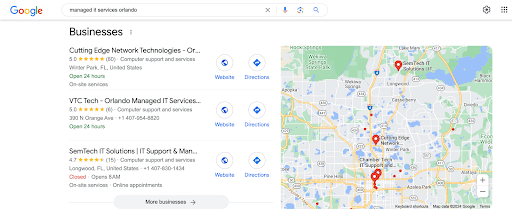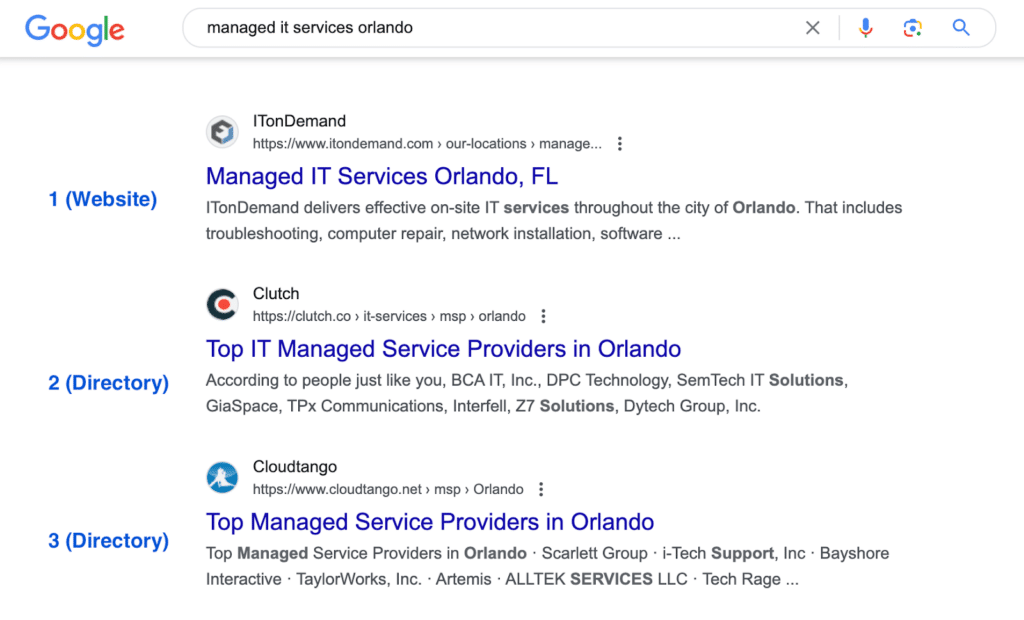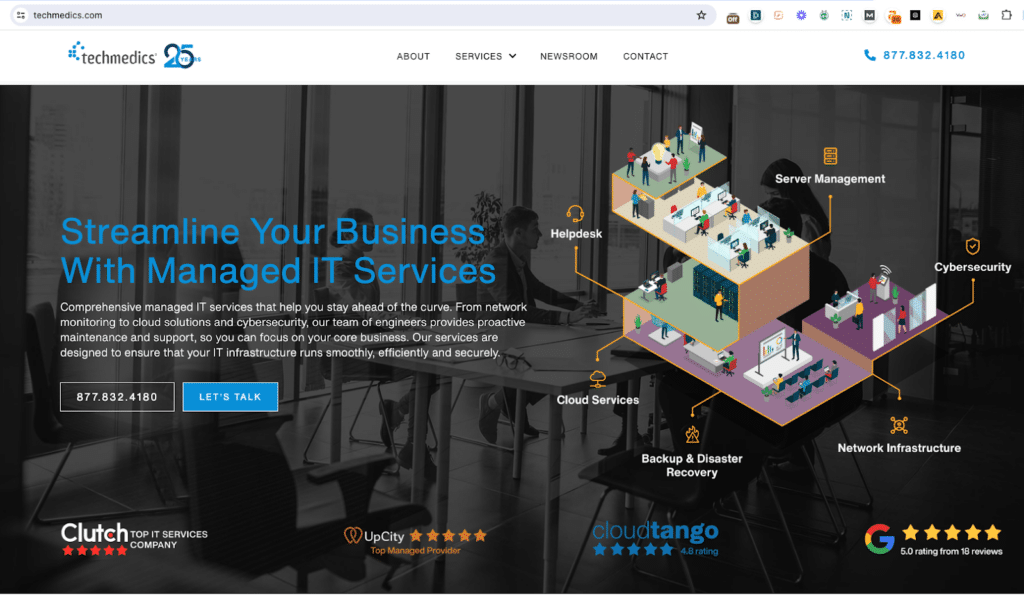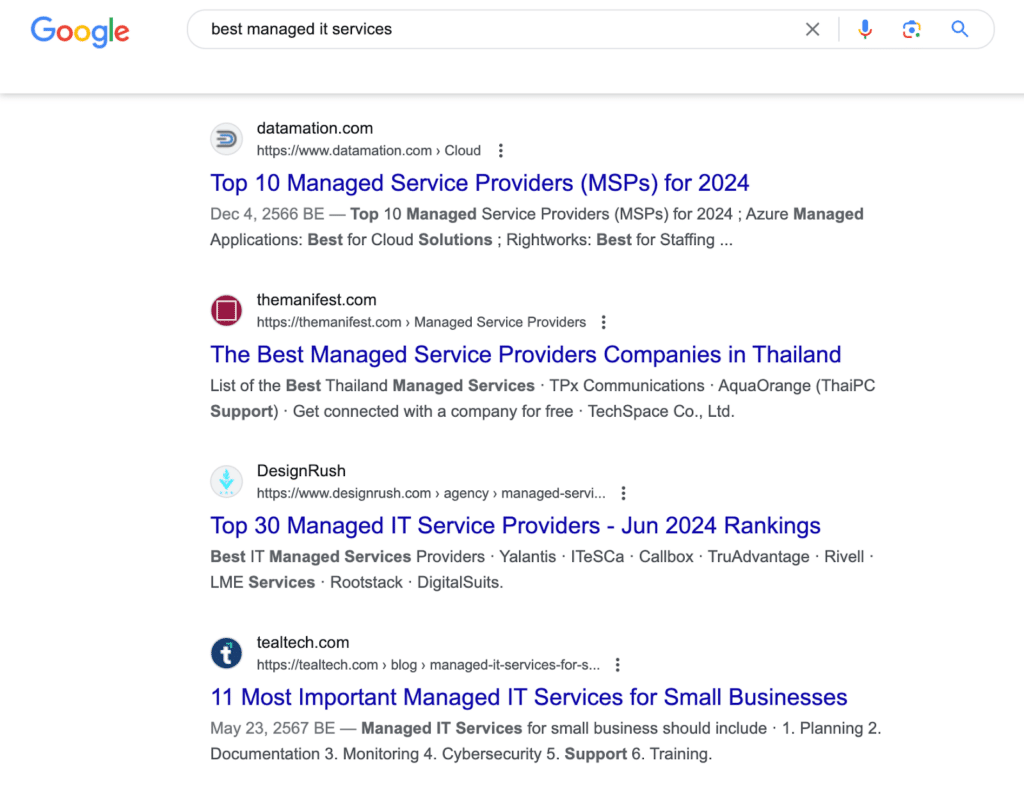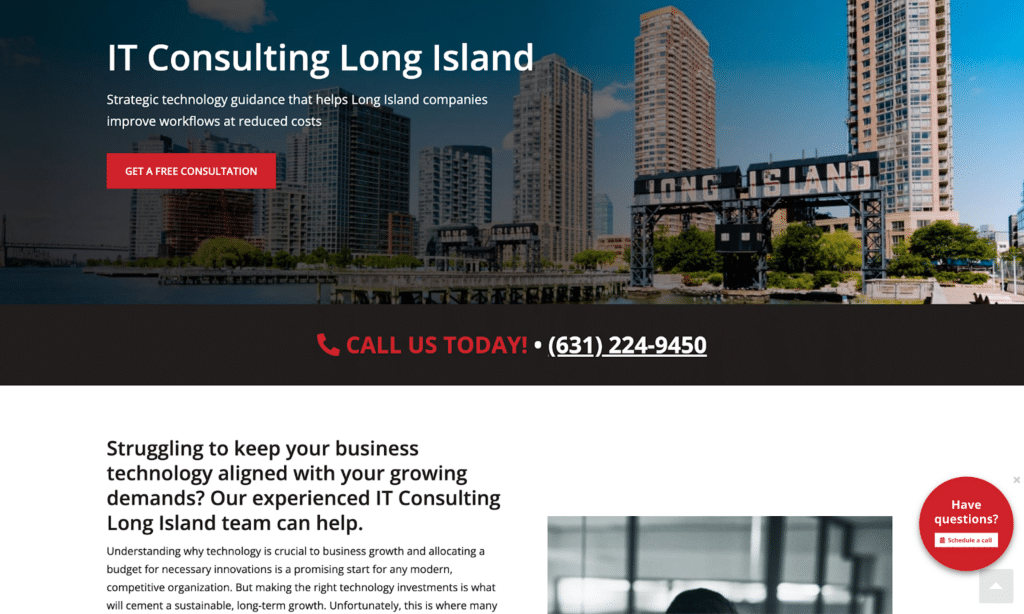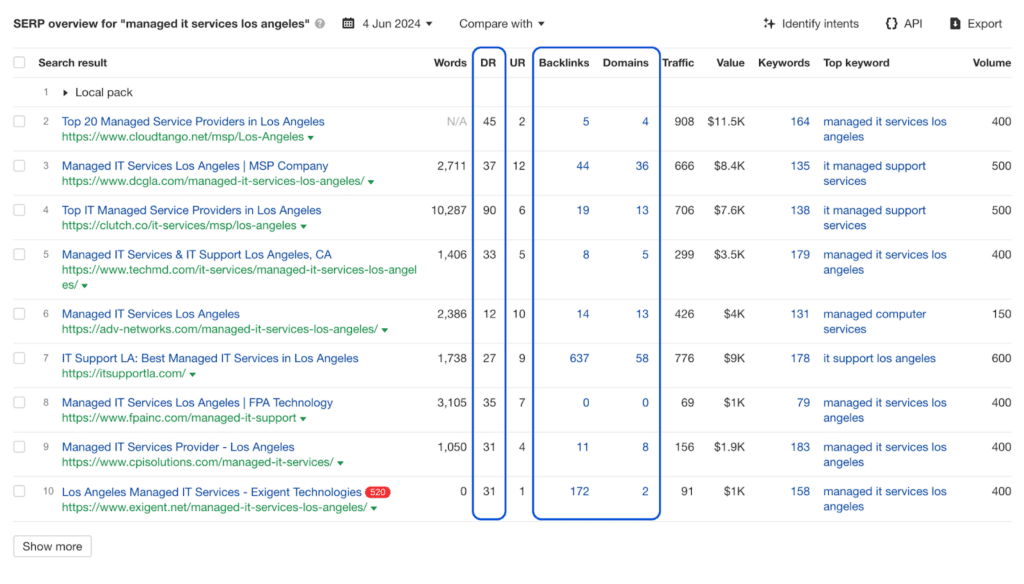If you truly want to grow your business beyond the 1 or 2-million-dollar ARR mark, outsourcing MSP marketing execution won’t be enough.
You have to understand which marketing activities your MSP needs to own and which you can actually outsource.
As a service provider for hundreds of MSPs, we can see that the landscape is hyper-competitive. It’s nothing like it was back in 2010 when putting a website up on Google was enough to gain a competitive edge.
To become a leading Managed Service Provider company, you must have an MSP marketing strategy to attract new clients and grow your business. This marketing strategy needs to be translated into an actionable MSP marketing plan that covers a wide range of offline and online marketing channels, including SEO, content marketing, paid search advertising, and reputation management.
So what’s the secret behind top-performing MSPs consistently attracting new clients?
They’re actively involved in their marketing with a solid strategy and digital marketing plan they’re actually using.
The good news is that throughout this article, I’ll give you some actionable steps to help attract prospects to your website.
What is MSP Marketing?
MSP marketing relies on the same basic principles as other B2B marketing, but it presents unique challenges for managed service providers.
The MSP services market is mature and competitive. Whether you’re a small local MSP or an established regional firm, to find new customers, you must invest in the right combination of traditional and online marketing tactics that will fit your budget and give you a competitive advantage in your target market.
MSP marketing is an integrated approach to generating demand for your IT managed services.
Broadly speaking, it covers marketing techniques that range from digital marketing strategy to traditional tactics such as lunch and learn events to more advanced Google Ad campaigns to attract qualified prospects.
Like other B2B companies, MSPs typically have a long sales cycle, which requires implementing not only short-term marketing tactics but also long-term tactics such as search engine optimization (SEO), brand building, and thought leadership programs.
The most successful MSP companies we’ve worked with have a well-defined strategy and use a blend of offline and online marketing strategies. They also provide feedback on campaign results, while Pronto takes care of the campaign execution and optimization for them.
Why Do MSPs Need a Marketing Strategy?
“If you market to everyone, you market to no one”.
The most effective MSP marketing campaigns and successful MSPs are the ones that can focus their marketing efforts on a specific niche or defined audience. Having an MSP marketing strategy is as much about deciding what to do as it is about deciding what not to do.
The broader your message is, the more generic and copyable it becomes.
This is why it’s important to start your strategic efforts by building an ideal client profile with specific characteristics.
Of course, when an MSP is small and doesn’t have the luxury of having many of the right leads coming in from its marketing efforts, it needs to be flexible and learn who’s an ideal client over time.
However, the sooner its marketing starts to be focused on serving a specific buyer, the sooner it’ll see its marketing efforts pay off.
6 Essential Components of an MSP Marketing Plan
“If you fail to plan, you are planning to fail!” a famous digital marketer once said (or Benjamin Franklin). Jokes aside, when you’ve got a solid MSP marketing strategy, you’re not wasting your time throwing the wrong pitch to the wrong people in the wrong place. Without research and planning, you’re just throwing spaghetti at the wall. That could mean months of hard work with little to show for it.
Throughout this article, we’ll cover the essential components your MSP marketing strategy needs to be successful. These include:
- Putting together a comprehensive strategy – Focus on your ideal client with a buyer persona and SWOT analysis, and which marketing channels to rely on.
- SEO strategy and execution plan – SEO is fundamental to any digital marketing approach for MSPs. A strong SEO strategy can have a lasting impact on your website.
- Content calendar – Create a content calendar of topics that show your business as an authority on IT issues.
- Paid search advertising – With the right setup, paid search can generate leads within weeks.
- Measured results – Tools to measure the impact of your strategy and which areas were most effective.
- Outsourced Marketing – If all the techniques and advice seem too much or you lack time, outsourcing your marketing may be an option.
Create a Buyer Persona and SWOT Analysis
When it comes to marketing your Managed Services Provider business, a SWOT analysis and buyer personas are a must. They help you understand your ideal clients and your business’s internal strengths and weaknesses and external opportunities and threats. These will help you create an MSP marketing plan to attract and retain clients.
Your Buyer Persona/Client Profile
Before you start the SWOT analysis, you need to have a clear picture of your ideal client. A detailed buyer persona helps you target your marketing to the specific needs and pain points of your target market. Use the questions below to ask yourself when creating your own buyer persona.
- Industry: What industries do your clients operate in (e.g. healthcare, finance, manufacturing)
- Company Size: Are they small businesses, mid-sized companies, or large enterprises
- Pain Points: What are their main IT challenges (e.g. cybersecurity, network management, compliance)
- Goals: What do they want to achieve with your MSP services (e.g. improved efficiency, reduced downtime, cost savings)
SWOT Analysis
Now that you have your buyer persona you can do the SWOT analysis. This will help you identify the internal and external factors that can help guide your marketing. Here’s a template to help you get started on your SWOT analysis.
Strengths
- What are our core competencies
- What unique resources do we have
- What do we do better than our competitors?
- What positive feedback do we receive from our clients?
Weaknesses
- What areas need improvement
- Where do we lack resources or expertise?
- What are our clients’ most common complaints?
- What processes or services are inefficient?
Opportunities
- What market trends can we capitalize on?
- Are there new technologies we can adopt?
- What partnerships can we form to enhance our offerings?
- Are there gaps in the market that we can fill?
Threats
- What are our competitors doing better?
- Are there changes in regulations that could impact us?
- What economic factors could affect our business?
- Are there emerging technologies that could disrupt our services?
Having a Specific Target Audience Helps MSPs Stand Out
You’ve probably heard the phrase “A jack of all trades is the master of none”. This can be applied to the market segments you target, or how you position yourself in the market. There are a few ways you can show off your unique expertise to really make your business stand out.
By Industry
Some MSPs may choose to focus primarily on a particular industry, for example, healthcare. Throughout their website, they show that their services are specifically catered towards the healthcare industry. This helps give healthcare professionals confidence that the MSPs have experience in their sector and have the specific expertise to help them.
One tradeoff to consider with such a targeted strategy is the limited search volume at a local level. This means that to get more organic traffic, you’ll need to rank for hyper competitive national keywords like “managed it services for healthcare”.
The size of the targeted metro area your MSP is located or even your region’s unique business specializations could mean that there are more healthcare providers and patients than in others.
Last but not least, you should take into account what level of specialization makes sense for your clientele and business strategy. Continuing with the healthcare industry example, it’s worth considering that it remains a diverse group of practitioners – dentists, surgeons, pediatricians, optometrists, pharmacists, general practitioners (GPs), acupuncturists, etc. This is true of healthcare practitioners as it is of manufacturers – two popular industries for MSPs to target.
The more targeted you are, the more impactful your campaigns can be. However, you may need to look beyond your metro area and state in order to continue growing, and therefore implement different sales & marketing strategies.
By Client Pain Point and Unique Selling Proposition
Understanding why prospects are shopping around for an alternative MSP or finding their first managed services provider can help you better market yourself to them. You can even turn their specific problem into your unique selling proposition.
For example, you might find a common reason clients come to you is their previous MSP’s service delivery was unreliable, with regular service interruptions and variability in service quality. You can then position yourself as “a partner committed to reliability, a guaranteed 99.9% uptime, and support calls answered within 5 minutes, even on the weekend”.
By Location
Targeting prospects by location is extremely common for MSPs, and in almost all cases, essential. Even larger, more national, MSPs often target particular cities they have an interest in. This is largely because if you target nationally, you’re competing against up to 40,000 MSPs for only 10 positions in Google’s Top 10. Whereas if you focus on your local cities, the competition drastically decreases. You can also potentially get more traffic by targeting multiple locations than if you were to only focus on national keywords. We’ll get more into how to do this with “location pages” below.
Case Studies: The Proof is in the Pudding
Whether it’s for converting visitors browsing your website, a Google Ads landing page, or closing a deal, your MSP and its salespeople will need Case Studies. While you can outsource some of the final production, this ultimately has to be produced from within your organization. Producing case studies for your ideal client profile(s) and different services will be key. Again, this is why having few client types and services actually helps keep your marketing easier and under control.
Having a compelling copy on your service pages is great, but you should also practice the mindset of “show, don’t tell”. Having case studies on your website shows that you don’t just talk the talk, but walk the walk too. Take our case studies page for an example, and in particular our MSP case studies. Because of our history working with MSPs, we doubled down on creating case studies to show that we know what to do to get results. If an MSP calls our sales team to know more about us, we’ll mention our case studies to help bolster their confidence in working with us. Case studies are a very powerful tool that really helps show your potential clients what you’re capable of.
Prospective clients most often visit our website’s case studies pages before reaching out to our sales team. You could even say that 70% of the selling happens BEFORE talking to a salesperson, so make sure they are easily accessible and don’t wait for a sales lead first.
Reviews: It’s Not Just for Restaurants, they Matter for Businesses (and SEO) Too
Google’s Business Profile
Other Specialized Directories
When searching for services in your area, you might come across directories like Clutch, UpCity, Cloudtango, or Expertise. Google often includes these directories in search results because users like having a list of companies to choose from. Sometimes, these directories take the top spots, making it difficult for individual businesses to outrank them. So, if you can’t beat them, join them!
To decide which directories to create a profile on, search for “Managed IT Services + Target Location,” such as “Managed IT Services Orlando.” In this example, the top directory is Clutch, followed by Cloudtango. It’s usually best to focus on the top-ranking directory, as they likely receive more traffic and ranking on these directories requires reaching out to clients for reviews, which can be time-consuming.
Additionally, look at how many reviews the top companies have. Since these directories use reviews to rank businesses, it might be beneficial to focus on a directory where you can more easily compete, even if it ranks in the top 10 but has fewer reviews.
Making the Most of your Reviews
Wherever you get your reviews, make the most of them on your website. Reviews are seen as a type of “social proof” that can really impact prospective customers’ decisions on who to partner with. Potential customers typically want to make the least risky decision, so seeing evidence that your current clients are happy with your services really helps make their decision easier.
Below is an example of how Techmedics added their reviews from Clutch, UpCity, Cloudtango, and Google to the banner section of their homepage.
SEO Strategies for MSPs
The keyword you want to appear in Google for
The answer the searcher is looking for (their intent)
The page’s content (does it answer their question)
Should You Choose a Local or National SEO strategy for YOUR MSP?
This is a little bit of a trick question, because you should almost always have a local element to your SEO. Why? Because most potential customers see MSPs as local businesses, and because the searches tend to be more local than national, Google sees MSPs the same way. That’s not to mean you can’t target nationally, though. It just means if you want to get traffic to your service pages, you need to have a local angle.
Local SEO Strategy
When it comes to your local SEO strategy, there are essentially two elements. One is creating locally targeted pages for your top services, such as “managed IT services Los Angeles.” We’ll discuss this more later. The second is ensuring that your Google Business Profile is completely filled in, has more reviews and a higher score than your competitors, and is regularly updated.
National MSP Strategy
When targeting a nationwide audience, there are two avenues we recommend MSPs take: creating pages that target specific cities worldwide (although keep in mind that this often requires additional investment and can be impractical to create 100 pages in one go) and creating blog articles. Creating blog posts is important as it can open up more keyword opportunities that have less competition, and so more likely to rank nationally. One thing that is rarely possible, though, is creating one page for “managed it services” and having it rank nationally. This is because Google often serves users with local companies for these service-based searches.
Location, Location, Location
If your office is located on a high-traffic highway where all the cars passing by every day can see your name loud and clear, this can actually work wonders for your brand awareness over time. But it’s not just the outside that can make a difference; it’s also the inside. While the MSP model’s goal is to manage clients’ IT remotely, bigger clients with a higher propensity to spend will still want to ensure that they’re outsourcing their IT network and management to a professional company with superior or enterprise-level infrastructure and capacities.
Multiple Locations
It is still possible to rank your website for multiple cities with one or no physical location, but having multiple physical locations can help boost your online presence. If you do have multiple locations, make sure each one has a Google Business Profile and a dedicated page for each location.
Local Chamber of Commerce
Being part of the local chamber of commerce is more than just a business move—it’s about becoming a trusted member of the community. Listing your business in chamber directories and actively networking with fellow members puts your name in front of local businesses and builds credibility. You can find your local chamber of commerce in the U.S. here and in the UK here.
To understand the power of being involved with your local chamber of commerce, listen to the podcast episode below in which 360IT Partners CEO, Martin Joseph, shares how his involvement in their local chapter has been a stepping stone for his MSP’s growth.
Keyword Research
Before creating any page for search traffic, start with keyword research. This is because you want to assess the demand for that keyword (or, keyword volume). In the example below, you can see the search volume is 150 for the keyword “Managed IT Services Tampa”. This means that there are approximately 150 searches for this exact keyword per month. This doesn’t include people who are searching for similar keywords like “Tampa Managed IT Services”, but if you rank for one keyword, your page is likely to rank for close variants.
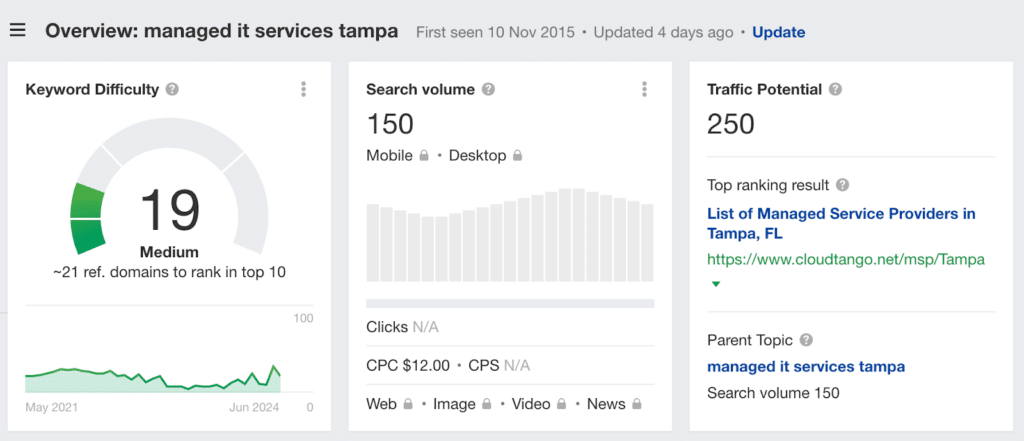
📍Local Keywords
At Pronto, when working with MSPs, we highly recommend going after local service keywords, such as “Managed IT Services Tampa.” One core reason for this is that local keywords are less competitive. Instead of competing with every MSP in the country that offers that particular service, you’re competing with only the MSPs offering that particular service in the city you’re targeting.
We’ve worked with thousands of MSPs, and from our experience, there are 3 main services that prospects search for locally. These are:
- Managed IT Services
- IT Support
- IT Consulting
Knowing this will save you a lot of time when looking for keywords. Simply add a location after one of these services in your keyword research tool of choice to see which has demand in your area, for example, “Managed IT Services Chicago”.
We created a comprehensive video tutorial on local keyword research. This video is a deep dive and I highly recommend you check it out to learn some tricks and techniques to find keywords to target.
On-Page Optimization
Once you have your target keyword, the next step is to create the content for your page. There are a few important steps to take note of here.
Searcher Intent
Make sure your content matches the searcher’s intent — meaning your page answers their question well. For example, if your target keyword is “best managed it services”, the searcher is looking for a list. If your page doesn’t have a list, then you likely aren’t answering their question. How do I know this keyword requires a list? I check Google! Google is an expert at understanding searcher intent, so it’s usually a good idea to put your keyword into Google to see what “type” of content it’s showing. See if the content is informational, local, product, or service-based.
Secondary Keywords
Although Google is an expert at understanding searcher intent and page content, you still need to ensure you’re giving Google enough information and clues to match your page with searchers. So, if your page is about “IT Support,” be sure to include all relevant words and phrases associated with this. Most of the time, this will come naturally, but it’s still something to be mindful of.
Examples of secondary keywords for an “IT Support” page might include:
- Technical assistance
- Computer troubleshooting
- Network maintenance
- Software installation
- Hardware repair
- Remote support
- Help desk services
- System updates
- Cybersecurity solutions
- Data backup and recovery
By naturally incorporating these related terms, you might write sentences like:
“Our IT support team offers expert technical assistance for all your computer troubleshooting needs.”
“From network maintenance to software installation, we’ve got your business covered.”
“Need remote support? Our help desk services are available 24/7.”
Content-Length
Some keywords require more written content than others. For example, if your target keyword is “photos of servers”, you won’t need to write a lot of content. Instead, you’ll need a lot of… photos! Again, this is about “searcher intent”. If your page has a lot of written content and no pictures, then you’re not matching your content with what searchers are looking for. There is a very simple way to know how much written content and what type of content you need, and that’s to check the search results again. If the top 10 results tend to have 2,000 words, then that’s a good signal that Google prefers to show results with that much content.
On-Page Optimization Tools
After understanding these core features of on-page optimization, I’m now going to save you hours of time with these tools. These tools are designed specifically for on-page optimization, including guiding you on content length, which secondary keywords to use, and even how often to use them. If you are serious about SEO, bookmark these links.
SurferSEO is a powerful on-page optimization tool designed to help you rank higher in search engine results. It analyzes top-performing pages for your target keywords and provides actionable recommendations to improve your content, including keyword usage, word count, and structure. SurferSEO’s data-driven approach ensures your content is aligned with current ranking factors, making it easier to outrank competitors.
Clearscope is a content optimization platform that enhances your writing by offering keyword insights and content recommendations. It uses natural language processing (NLP) to analyze top-ranking content and suggests relevant terms and topics to include. Clearscope helps you create comprehensive, high-quality content that meets the search intent of your audience, ultimately improving your SEO performance.
Frase is an AI-powered content creation and optimization tool that streamlines the research and writing processes. It generates detailed content briefs based on your target keywords and competitor analysis, helping you produce SEO-friendly content quickly. Frase also offers features like answer extraction and topic clustering, making it a versatile tool for improving your content strategy and boosting organic traffic.
Page Optimizer Pro (POP) is a sophisticated SEO tool that provides precise on-page optimization recommendations. By analyzing your target keyword and comparing it with top-ranking pages, POP suggests specific changes to improve your content’s SEO performance. The tool offers insights on keyword placement, content structure, and technical SEO elements, ensuring your pages are optimized for better search engine visibility.
Location Pages
Get ready for another time-saving tip for your MSP SEO marketing. If you’ve read my other articles you would have heard me say time and time again (here, here, and here) that location pages are essential for MSPs and service area businesses. Location pages are essentially pages created to target prospects in areas that you serve. For example, if your business is located near Tampa, and you’re able to service this city, you should be targeting Tampa with a location page.
This is also where the location keywords I mentioned previously come into play. For example, “IT Consulting Long Island”. The caveat is that not all cities are big enough to make a dedicated page worthwhile, so make sure you check that search volume. Any search volume higher than 50 means a page is worth creating.
Backlink Building
Backlinks are essentially links from a website to yours, and they are a key indicator used by Google to understand how authoritative a website is. Backlinks are also one of the three pillars in SEO (the others being content and technical SEO). So there’s no getting around it: You need backlinks, and it’s likely your competitors are already building them and have been for years.
The screenshot below shows the search results for the query “Managed IT Services Los Angeles.” This term has a high search volume of 400 p/m, so it’s obviously very competitive.
The highlighted DR column stands for Domain Rating. This is a metric created by Ahrefs to give marketers and website owners an idea of how authoritative Google sees their website. This metric is primarily influenced by backlinks coming to their website. The backlink and domain columns show how many domains (websites) are linking to each website in the search result and the total number of backlinks going to each result.
It’s not a perfect science, and there are some assumptions involved, but this gives us an idea of how many backlinks and how high a DR needs to be to stand a good chance of ranking for “Managed IT Services Los Angeles”. On the lower side, a website wanting to rank its page should have a minimum of DR12 and 13 domains linking to its page.
How to Get Backlinks
There are a few different techniques to get backlinks. Here are 3 of the most common.
Skyscraper technique: This involves finding a blog on your competitor’s website and writing your own bigger, better version. Then, email all the websites that have linked to your competitor’s page and let them know you have a bigger, better version that would benefit their readers. Cheeky, I know!
Broken link building: For broken link building, the idea is to use SEO tools to find 404 pages on your competitor’s website that have multiple backlinks pointing to them. You can then use tools like Wayback Machine or simply see what the back was about by looking at the URL, then create your own version. You would then email all the websites alerting them that they are linking to a broken link and offer them your blog to link to instead. Slightly less cheeky.
Guest post link building: Another popular approach is to write your own blog articles for other websites. Within the content of the blog, you would reference a service or blog page on your website. You would then reach out to websites and offer your article for their website. It’s a win-win since they are getting free content, and you’re getting a backlink to your website.
Want some more ideas? Here are 3 practical ways to build links to your website.
Technical SEO
At its core, technical SEO is just making sure your website is easily crawlable by Google and other search engines. For example, your pages load quickly and you don’t have broken links. Technical SEO can be less nuanced than other parts of SEO.
To get started, you’ll need to sign up for a tool that scrapes your website. Some popular tools are SEOptimer, SEMrush, and, of course, our favorite Ahrefs. Once you’ve signed up and finished crawling your website, the tools will give you a list of errors that you can hand over to your webmaster to fix.
Read our comprehensive MSP SEO Guide to continue learning how to rank higher.
MSP Content Marketing Strategies
Content marketing involves creating and sharing content online. This can be anything from creating blogs, writing newsletters, or posting on social media. Here we’re going to focus on creating blogs. If you have a solid understanding of how to create blog content, then you can use this in your social media or newsletter campaigns.
Why You Should Create Blogs
Writing blog content is an important way to educate and engage potential customers and establish your MSP as a trusted authority in the industry. When businesses think about blogs, they often think about SEO and ranking in search engines. Blogs are a great way to increase your website traffic, but they can also educate potential customers during the sales process.
How to Find Topics to Write About
There can be a keyword research angle to this question, but one of the best ways to find topic ideas is to listen to your customers. For example, some pain points your prospects might have are:
- Unreliable IT Support
- Poor Network Security
- High Downtime
- Slow Response Times
- Lack of Proactive Maintenance
- Outdated Technology
- High IT Costs
- Inadequate Data Backup and Recovery
- Limited IT Expertise
- Compliance Issues
- Lack of Scalability
- Inconsistent Service Quality
- Poor Communication
- Insufficient IT Strategy
- Vendor Management Challenges
- Security Breaches
- Software Integration Issues
- Limited Remote Work Support
- Difficulty in Managing Multiple Devices
- Lack of Customized Solutions
You can then turn each of these into blog posts. The next time you talk to a prospect on the phone who says the reason they are looking for a Managed Services Provider is to reduce their IT costs. You can then mention to them that it’s a common reason businesses come to you and that you’ve even written a blog on it called “Reducing IT Costs Without Compromising on Quality”. The idea is to develop high-quality, educational content that addresses the target audience’s pain points and showcases your MSP’s expertise.
Here are some more topic ideas based on these pain points:
- How to Ensure Reliable IT Support for Your Business
- Top Network Security Measures Every Business Should Implement
- Minimizing Downtime: Strategies for Continuous Business Operations
- Why Slow Response Times from Your IT Provider Could Be Costing You
- The Importance of Proactive IT Maintenance in Preventing Issues
- How Outdated Technology Can Hurt Your Business and What to Do About It
- Reducing IT Costs Without Compromising on Quality
- Essential Data Backup and Recovery Strategies for Businesses
- Bridging the IT Expertise Gap in Your Organization
- Navigating Compliance: How an MSP Can Help
- How to Ensure Your IT Infrastructure Can Scale with Your Business
- Why Consistent Service Quality is Crucial for IT Support
- Improving Communication with Your IT Service Provider
- Developing an Effective IT Strategy for Business Growth
- Simplifying Vendor Management with the Right MSP
- Protecting Your Business from Security Breaches with an MSP
- Overcoming Software Integration Challenges in Your Business
- Supporting Remote Work: How an MSP Can Help
- Effective Management of Multiple Devices with Managed Services
- Signs It’s Time to Switch Your MSP
Make the Most out of Your Blog Content
Blogging is a fantastic way to establish thought leadership and build trust with potential customers. Once you start writing blog posts, make sure you’re not wasting your hard work. You should be squeezing as much out of your blogs as possible by posting them on social media and sending them out to any mailing lists you have.
Pay-Per-Click (PPC) Advertising for MSPs
For MSPs, Google Ads is not only one of the best ways to get in front of your prospects but also to protect your brand and competitors from stealing traffic away from you. It gives you full control over what search phrases your ads appear under and the location of the searcher.
Compared to SEO, PPC can give you much more granular control over when your ad is showing. Also, where SEO is a long game, PPC is more like an on-off switch. You can potentially get leads faster, but as soon as the campaign stops, so do those leads.
Google makes the onboarding easy but forgets to tell you how complex Google Ads really are and how much ongoing work it takes to actually ‘make them work.’ It’s easy to waste a lot of money if you’re not paying attention and know how to manage your campaigns.
Considering how easy Google makes it to set up campaigns in Google Ads, it’s hard not to be pulled in and want to set up a few campaigns. But unless you plan to actively manage your campaigns and instead decide to put them on auto-pilot, you’ll end up flushing hundreds of dollars down the drain for nothing.
Once you’ve developed and launched a well-organized campaign, you can really dig into which ad groups are getting clicks and which are getting conversions. Some improvements you can make in your campaigns to get them really working are:
Ad Groups
- Services: Start by categorizing your services (we recommend covering these services; Managed IT Services, IT Support, and IT Consulting). Each ad group should be focused on a specific service.
- Keyword Research: Use Google Keyword Planner to find keywords for each ad group. Target local keywords like “Managed IT Services Tampa” to capture search intent in your service areas.
- Create a Keyword Group Targeting Your Company Name: Not only does this help you appear more often in search results, it’s actually really cheap to do while increasing the costs for competitors.
- Ad Copy: Write ad copy for each ad group. Make sure your ads highlight the benefits and include a call-to-action (CTA). For example “Get IT Support in Tampa – Call Now for a Free Consultation!”
- Ad Extensions: Use ad extensions to add extra information, such as site links, callouts, and structured snippets. This increases the visibility and effectiveness of your ads.
Weekly Negative Keyword Checks
- Search Terms: Review the search terms report to see what queries triggered your ads. Remove irrelevant or low-performing search terms.
- Negative Keywords: Create a list of negative keywords to stop your ads from showing for irrelevant searches. This will reduce waste, save your ad budget, and improve the quality of your traffic.
- Ad Group Refining: Adjust your keyword strategy based on performance data. If certain keywords are consistently getting clicks but no conversions, add them as negative keywords or refine your ad copy.
Landing Page
- Relevant and Specific Pages: Each ad group should direct traffic to a relevant landing page that is specific to the service in the ad.
- Clear Value Proposition: Highlight your USPs and explain why the visitor should choose your MSP services. Include headlines, bullet points, and client testimonials.
- Strong Call-to-Action: Include a clear and compelling CTA. Whether it’s a contact form, consultation, or phone call, make sure the next step is obvious and easy to take.
To learn more best practices on how to get more leads, read our MSP Google AdWords Management guide.
Essential Website Elements to Convert Visitors
Finally, let’s talk about turning website visitors into customers. What strategies can boost your conversion rate? We covered this recently on our YouTube channel, and to highlight some must-have elements, we always recommend these:
- Awards – If you have any awards, show them off! Make sure they are easily seen by all visitors. They could be placed near the main banner on your homepage or next to contact forms. Make sure they are not missed. Prospects do not like to take risks, so give them confidence by showing off your awards.
- Reviews – Similar to awards, rewards are just as important to show off. Reviews are also known as “social proof”, and they can really help instill confidence in prospective customers if they see similar customers have had a great experience with you.
- Company stats – One great way to stand out from your competitors is to provide performance metrics on your website. This not only shows what you can deliver, but it shows that you care enough about your customers and work to track your performance. For example, this could be how many clients you’ve worked with or your response time to tickets.
Newsletters & Email Marketing
Email marketing is a powerful tool for MSPs with an ROI of 3800% according to DMA. To get the most out of it MSPs should focus on 5 key areas: knowing your audience, segmenting your list, personalizing messages, telling impactful stories, and including clear calls to action. These will help create relevant content that resonates with the recipient and gets them to take action.
Good MSP marketing emails start with knowing your audience and tailoring the tone and content to them. Segmenting your email lists allows for more targeted messaging, and personalization helps build one-on-one relationships with your contacts. Storytelling can grab attention and differentiate your emails from the hundreds of others in the recipient’s inbox. Format your emails for scanning, as many will only spend a few seconds reading the content.
Finally, every marketing email should have a clear, singular call to action that aligns with the email’s message and moves recipients forward in their buying journey.
Webinars, Videos, and Podcasts
This is probably not for everyone, and it requires a certain amount of time commitment and production effort, but more MSPs are making the leap to video and podcast creation, especially as they grow. This can also be a great way to kill two birds with one stone and build up a YouTube presence simultaneously. While creating this type of content requires time and effort, it will fuel your marketing efforts, whether on your site or email marketing efforts
Creating videos, webinars, and podcasts can help give your brand a personal touch and really help prospects get to know you and how your team works. It’s also a great way to stand out from the competition. Two great examples of MSPs creating video content are Integris and CDN Technologies. CDN Technologies has also invested time in creating podcasts that can easily be repackaged for YouTube. If you do invest time in creating webinars and podcasts, two tools we recommend trying are Riverside and Descript.
Attending Industry or Tech-Specific Trade Shows
If you’ve made a strategic decision to focus on a specific tech or industry, it can become easier to choose which events to attend and which not to attend. Attending trade shows is all about meeting the audience where they are. This allows you not only to learn what the pressing issues are in their industry but also to build relationships over time. As you become more familiar with that industry’s needs, it also becomes easier to be accepted as a guest speaker and become a thought leader.
Measuring Success & Tracking Progress
Without tracking and measuring your marketing efforts, it’s hard to know exactly what you’re doing right (and wrong). As an MSP, understanding which strategies and tactics are driving conversions and delivering the highest ROI is crucial for refining your approach and ensuring ongoing success. This could be measuring how many leads a recently built location page is getting, how much traffic recent blog posts are getting, or how successful an ads campaign is.
Analytic Tools
When most people think about analytic tools, they probably think of Google Analytics. Although Google Analytics is the go to for tracking website traffic, there are more user-friendly tools that help display information better. When measuring and tracking campaign progress, these are our go-to analytic tools.
- WhatConverts – WhatConverts is specifically for tracking leads. It provides an easy way to track form submissions, and you can also set up call-tracking numbers to track leads via phone calls.
- Agency Analytics – Agency Analytics’ strength lies in its ability to integrate with most other marketing tools. You can pull data from WhatConverts, Google Analytics, and many more apps.
- Google Search Console – Google Search Console is the analytics dashboard that shows you how your website appears in Google Search results.
When Should You Outsource Your Marketing
For some, outsourcing marketing work can be the best move for your company. Outsourcing your marketing can allow you to focus on your core business while experts handle your campaigns. By partnering with a marketing agency or consultants you can tap into their knowledge and experience in the MSP industry and get efficient and effective marketing. Here’s why outsourcing your marketing could be a better idea for your MSP:
- Access to Expertise – Marketing agencies have a team of experts in various aspects of digital marketing from SEO and content creation to social media management and PPC advertising. Their expertise can help you craft strategies that resonate with your target market and get results.
- Cost Effective – Hiring a full-time in-house marketing team can be expensive. Outsourcing allows you to access top talent without the overhead costs of full-time employees like salaries, benefits and training.
- Scalability and Flexibility – Outsourcing gives you the flexibility to scale your marketing up or down according to your needs and budget. Whether you need a full marketing campaign or support for a specific project an outsourced team can adapt to your requirements.
- Focus on Core Competencies – By outsourcing marketing tasks your internal team can focus on what they do best: delivering great IT services to your clients. This focus will lead to better service delivery and client satisfaction.
- Fresh Perspectives – External marketing teams bring new ideas and perspectives to the table. They can provide insights you may not have thought of, help you stay ahead of the competition, and continuously innovate your marketing.
- Advanced Tools and Techniques – Marketing agencies have access to advanced tools and technologies that can enhance your marketing. These tools can give you deeper insights into your campaigns, allowing you to make more informed decisions and get better results.
- Time-Saving – Developing and executing an MSP marketing strategy takes a lot of time. Outsourcing can save time and get marketing tasks done quickly and professionally.
Choosing the Right Marketing Agency to Partner with
When choosing a marketing partner for your MSP, make sure they understand the unique challenges and opportunities in the MSP industry. Below are a few different types of agencies.
- Done-For-You Marketing Agencies – Agencies like Technology Marketing Toolkit and Vertical Axion, which are best for MSPs with no sales and marketing processes and who are looking to be involved in a peer group.
- Growth / “Bespoke” – Best for MSPs looking for a full-service marketing agency like Tech Pro Marketing, Ulistic, MSP LaunchPad, and Mojenta.
- WordPress & SEO Agencies – Like Pronto Marketing (that’s us! 😉) and Marketopia, agencies that focus on SEO and WordPress-built websites.
Whatever type of agency you choose, it’s important to look for the following to ensure you’re signing up with a credible, experienced company that can deliver results.
- Industry Experience – Look for agencies that have experience working with MSPs or IT service providers. They will be more familiar with your target market and the marketing tactics that work best in your industry.
- Proven Track Record – Check the agency’s portfolio and case studies for examples of previous work. Look for results and testimonials from happy clients.
- Clear Communication – Communication is key to a successful partnership. Ensure the agency is responsive, transparent, and easy to work with.
- Performance Metrics – Make sure the agency uses data-driven methods to track and measure the success of your marketing campaigns. Regular reporting and analysis will help you see what’s working and where to adjust.
- Request Case Studies – Ask potential marketing partners for case studies that highlight their previous successes. Reviewing detailed case studies will give you insight into their approach, problem-solving capabilities, and the tangible results they have achieved for other clients.


